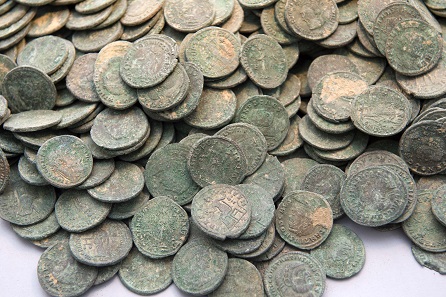by Björn Schöpe
translated by Annika Backe
May 12, 2016 – On April 27, 2016 a huge coin hoard was discovered in Tomares in southern Spain: construction workers found almost 600kg of Roman coins. They reported their find to the relevant authorities. The work has been suspended.
19 smaller amphorae were discovered, filled to the brim with coins. Photograph: © Consejería de Cultura / Junta de Andalucía.
The coins were stored inside 19 amphorae, of which ten were broken during the work, according to media reports.
They consist of folles that date back to the 3rd and 4th centuries A.D. Photograph: © Consejería de Cultura / Junta de Andalucía.
Dating back to the 3rd and 4th centuries A.D., the coins are reportedly folles of which some still exhibit the complete silver sweating.
There have as yet been no identification and analysis. Photograph: © Consejería de Cultura / Junta de Andalucía.
Ana Navarro, archaeologist in charge and head of Seville’s Archaeology Museum, emphasized that the economic value may amount to several millions whereas it would be impossible to estimate the historical value. She called the find unique for Spain, and only very few similar discoveries were made in the entire Roman Empire so far.
This might be a bit over the top – perfectly understandable considering the excitement about the discovery. Several finds have provided us with much information about the exact dates and the mint structure used to produce late Roman coins. However, perhaps hitherto unknown variants might enrich the already complete picture with new facets.
Depending on date and condition, the material value of folles of the usual type ranges between 20 and 200 euros. With an average weight of 8g, each kilo most likely consists of 125 folles, adding up to 75,000 folles in the entire hoard. The total economic value of the hoard, therefore, might well be about 750,000 euros.
Apparently, the newly-minted coins were packed right away, to be used to pay larger sums of money, perhaps to soldiers. Photograph: © Consejería de Cultura / Junta de Andalucía.
The coins are said to be in a very good condition since they appear to have been packed immediately after being minted. Archaeologists believe that the coins were intended to be used to pay levies to the army or for administrative purposes.
The find is currently kept in Seville’s Archaeological Museum where the coins will be inventoried, cleaned and catalogued. Photograph: © Consejería de Cultura / Junta de Andalucía.
The find was brought to the Archaeological Museum of Sevilla where the coins will be inventoried, cleaned and catalogued. In a second step, numismatists and historians can interpret the material and put it into their historical context. According to the Ministry of Culture of the Regional Government of Andalusia, the material will be presented to the general public once further results could have been established. In the meantime, an archaeological investigation will be conducted on the site.
Please find the Archaeological Museum of Sevilla here.









